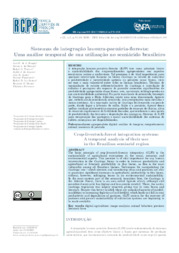Sistemas de integração lavoura-pecuária-floresta: uma análise temporal de sua utilização no Semiárido brasileiro.
Sistemas de integração lavoura-pecuária-floresta: uma análise temporal de sua utilização no Semiárido brasileiro.
Author(s): RANGEL, J. H. de A.; MORAES, S. A. de; TONUCCI, R. G.; AMARAL, A. J. do; ZONTA, J. H.; SOUZA, S. F. de; SANTOS, R. D. dos; MUNIZ, E. N.; PIOVEZAN, U.
Summary: Resumo: A integração lavoura-pecuária-floresta (ILPF) tem como princípio básico a sustentabilidade dos empreendimentos agropecuários nos aspectos econômicos sociais e ambientais. Tal premissa é de vital importância para qualquer intervenção humana no bioma Caatinga no intuito de aumentar a produtividade e lucratividade agrícola ou pecuária nesse bioma, visto ser esse o mais vulnerável entre todos os biomas brasileiros. Técnicas de manipulação do estrato arbóreo/arbustivo da Caatinga e introdução de culturas e pastagens são capazes de garantir aumentos significativos da produtividade agropecuária desse bioma, sem, no entanto, infringir perdas na sua sustentabilidade ambiental. Na parte mais Leste do semiárido, transição da Caatinga para a Mata Atlântica existe uma zona denominada Agreste que, embora ainda considerada semiárida, tem precipitações mais elevadas e menos erráticas. Aí a vegetação nativa de Caatinga foi removida em grande parte, dando lugar a lavouras de milho, feijão e a pecuária. Apesar dessa melhor condição pluviométrica ocorrem períodos de escassez de chuvas, além de crescente esgotamento da fertilidade dos solos, que conduzem a uma queda de produtividade das lavouras e degradação das pastagens. Sistema de ILPF para recuperação das pastagens e maior sustentabilidade dos sistemas de cultivo, começam a ser disponibilizados. [Crop-livestock-forest integration systems: a temporal analysis of their use in the Brazilian Semiarid region]. Abstract: The basic principle of crop-livestock-forestry integration (CLFI) is the sustainability of agricultural enterprises in the social, economic and environmental aspects. This premise is of vital importance for any human intervention in the Caatinga biome in order to increase productivity and agricultural or livestock profitability in that biome, as this is the most vulnerable among all Brazilian biomes. Techniques for manipulating the Caatinga tree / shrub stratum and introducing crops and pastures are able to guarantee significant increases in agricultural productivity in this biome, without, however, infringing losses in its environmental sustainability. In the most eastern part of the semiarid, transition from the Caatinga to the Atlantic Forest, there is an area called Agreste which, although still considered semi-arid, has higher and less erratic rainfall. There, the native Caatinga vegetation was largely removed, giving way to corn, beans and livestock. Despite this better rainfall, there are periods of scarcity of rainfall, in addition to increasing depletion of soil fertility, which leads to a fall in crop productivity and degradation of pastures. CLFI system for the recovery of pastures and greater sustainability of cultivation systems are beginning to be made available.
Publication year: 2020
Types of publication: Journal article
Unit: Embrapa Semi-arid Region
Keywords: Agropecuária digital, Análise de imagem, Brasil, Caatinga, Comportamento Animal, Digital agriculture, ILPF, Integração Lavoura pecuária Floresta, Nordeste, Precison livestock farm, Sistema CBL, Sistema de Produção, Sistemas agrosilvipastoril, Sustentabilidade ecológica, Zootecnia de precisão
Related content
Observation
Some of Embrapa's publications are published as ePub files. To read them, use or download one of the following free software options to your computer or mobile device. Android: Google Play Books; IOS: iBooks; Windows and Linux: Calibre.
Access other publications
Access the Agricultural Research Database (BDPA) to consult Embrapa's full library collection and records.
Visit Embrapa Bookstore to purchase books and other publications sold by Embrapa.

